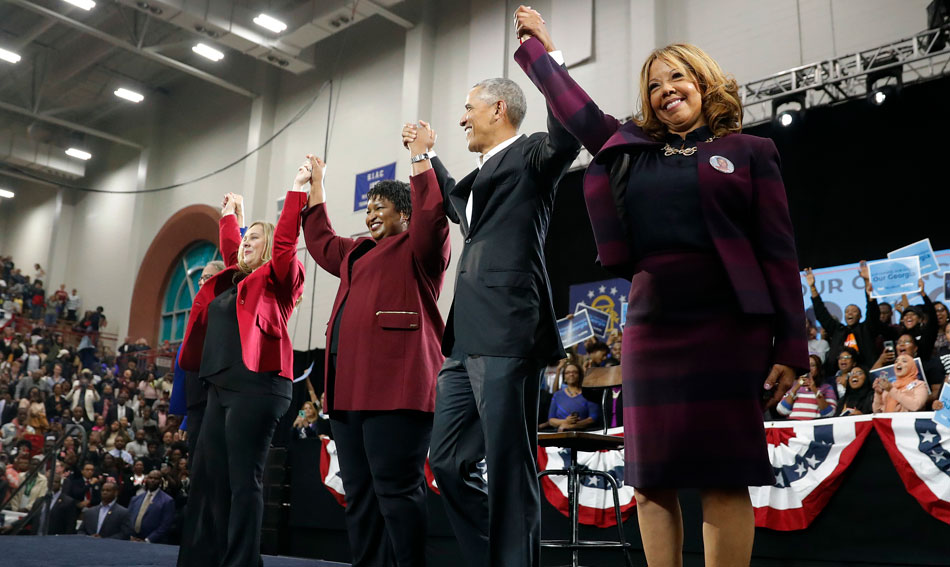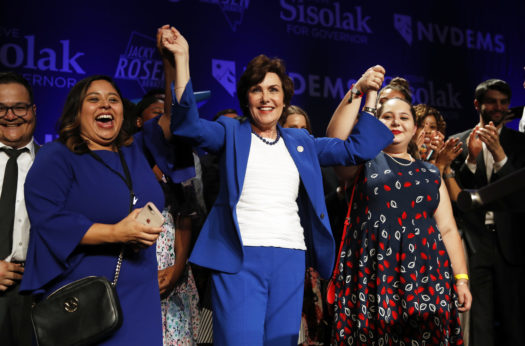
The outcome of the 2018 midterm elections was a big victory for the American people, Democrats, and allied movements, despite GOP gains in the U.S. Senate. Republican monopoly of government has been broken and the political terrain significantly reshaped for battles ahead, including the 2020 elections.
Any notion the election result was a “split decision” obscures what really happened on November 6. This was the biggest “blue wave” since 1975, and voter suppression and gerrymandering prevented even more victories, including in Florida, Georgia (results of both not known as of publication), and Texas.
This was a major repudiation of Trump, the GOP, and right-wing policies—including white supremacy, anti-immigrant hate, anti-Semitism, Islamophobia, homophobia, misogyny, and denial of the climate crisis. A majority of people voted against GOP candidates. Despite losing three seats held by incumbents, Democratic Senate candidates got close to 45 million votes and Republicans just 33 million (57 percent to 42 percent).
In addition to flipping over 30 seats to win the House majority, Democrats flipped seven governorships, over 330 state legislative seats, multiple state legislatures, and broke supermajorities in others.
Republican Senate gains took place in so-called red states, a very difficult terrain for Democrats to defend. And yet, in every race (except North Dakota and Indiana), Democratic candidates scored over 45 percent of the vote. With stronger statewide infrastructure, including in rural areas, and more effective candidates, these races can be more competitive.
Health care coverage emerged as a key issue including defense of the Affordable Care Act (ACA) protections for people with pre-existing conditions. Voters in three so-called red states—Utah, Nebraska, and Idaho—passed ballot measures expanding Medicaid.
Since the election, Trump has become unhinged, belying rosy pronouncements the GOP scored a “total victory.” In anticipation of Democratic control of the House, Trump fired Attorney General Jeff Sessions in what is widely viewed as an effort to subvert the Mueller investigation, an action that may very well precipitate a constitutional crisis.
With a House majority, Democrats will be able to block GOP legislation to kill the ACA, slash Medicare, Medicaid, and Social Security, and give further tax breaks to the rich. They will also advance an agenda that establishes the stark differences between the two parties as they work with the mass democratic movements.
In her post-election press conference, incoming House Speaker Nancy Pelosi identified priority issues for action: lowering health care costs, jobs and infrastructure, transparency and oversight, and campaign finance reform.

The victories are the result of incredible movements and struggles waged since election night 2016. They are especially the result of the leading role of women, people of color, and the mobilization by democratic movements. Tens of millions of people, especially first-time voters were engaged.
Many of those elected arose out of these grassroots struggles, including from the #MeToo, Black Lives Matter, Immigrant Rights, anti-gun violence, organized labor, LGBTQ, environmental justice, and other democratic movements. They include Lucy McBath, the new Democratic Congresswoman for Georgia’s 6th District, whose son Jordan Davis was the victim of a racist murder.
This development has few parallels in our history. The newly elected activist officials will help transform legislative bodies at every level and serve as an organic connection with the mass movements that helped elect them.
The post-Civil Rights and Voting Rights Acts era may be comparable—a time when thousands of African Americans were elected across the South, and later Mexican Americans and women. Or the Progressive era, when socialists were elected as mayors and legislators.
Women, including African-American women, ran and were elected in record numbers at every level of government. Over 100 women are now in the House of Representatives, including the first Native American and Muslim women.
Twenty-two women won seats in the Nevada Assembly, making a female majority in the chamber—a historic first for the state. Nevada will be the first state legislature in U.S. history to have more women than men serving.
Three new African-American lieutenant governors, four new African-American attorneys general, and seven new African-American members of the House were elected.
The historic campaigns by Andrew Gillum, Beto O’Rourke, and Stacey Abrams inspired millions, especially women, people of color, and youth.
The 2016 and 2018 elections again revealed the severe limitations and fragility of U.S. democratic institutions and how easily many are being undermined—first and foremost the right to vote, but also the undemocratic nature of the electoral college and the U.S. Senate, where 83 percent of the population has only one half the representation.
But movements are growing for radical reforms to defend and expand democracy. They scored some momentous victories, including passage of ballot measures to restore voting rights to felons in Florida, to establish automatic voter registration, and redistricting commissions.
Despite this victory, without taking a long view of the struggle, it is easy to become impatient or get lost in the weeds. The GOP domination of government will not be broken in one or two election cycles, and the 2018 victories are the basis for future advances. But it is important to keep up a strategic focus on defeating the right and building the broadest unity possible, including left-center unity. This approach was critical to the victories on November 6 and is more necessary than ever to opening the door to more radical change down the road.
Through hate and hysteria directed at the migrant caravan, Trump and the GOP successfully instilled fear and mobilized their base in the so-called red states, especially in small towns and rural areas. Democrats often appeared to be caught flat-footed in their response.
The ads portraying the migrant caravan as a national security threat funded by Jews and Democrats were the most open appeals to racism, xenophobia, anti-Semitism, and Islamophobia that we have seen yet. The ads were inspired directly from the so-called “alt-right” fascist playbook. Trump deliberately targeted these states to hang onto the GOP Senate majority.
But the Trump-GOP racism, anti-Semitism, misogyny, and xenophobia cut both ways. It mobilized his base of supporters, but it also created the atmosphere which led to three domestic terror attacks before the election. The ads and terror attacks generated considerable alarm and drove many moderate voters, including many white women and working-class suburbanites, to vote for Democratic candidates.
The Trump and Republican tactics of hate and fear are realigning political forces. The GOP is a party of open white supremacy, conspiracies and paranoia, climate and science deniers, with a narrowing base. Meanwhile, the Democratic Party base is expanding and becoming more diverse.
However, tens of millions of white voters are still under the sway of toxic hate peddled by Trump, the vast right-wing mass media, and right-wing fundamentalist white evangelical churches.
There is no way forward without taking on this toxic stew of hateful ideas and organizing a united multi-racial movement against racism, anti-immigrant hate, misogyny, anti-Semitism, homophobia, and Islamophobia. Without decisive unity, our multi-racial working class will not be able to play a leading role in the social transformation to a more equitable society.

The electoral alliance that includes the Democratic Party, labor, racial and gender equity, immigrant rights, and other democratic movements can win on a 50-state, 3,000-county strategy and by building grassroots infrastructure everywhere.
It would be a mistake to simply rely on demographic shifts to bring change or accept the idea that “demographics is destiny.” Such an approach abandons the idea of multi-racial unity and abdicates the fight against racism. It concedes large swaths of white voters to the embrace of the right.
In fact, this is what happened. The Democratic Party either neglected or abandoned its organization in many of these states, suburbs, exurbs, small towns, and rural areas. De-industrialization and the decimation of the labor movement meant the main influences were too often right-wing media propaganda, the NRA, and right-wing evangelical churches.
Ultimately, there is no way to build a governing coalition, win a Democratic majority in the U.S. Senate and a stable electoral college majority without winning many states where the demographics are not as diverse. Making substantial gains among white voters is imperative. The Democratic Party has also drawn this conclusion and begun to pour more resources into organizing in every congressional district.
Congratulations to all who were a part of this great victory. On to greater movements, organization, unity, and greater victories in 2020 and beyond!












Comments